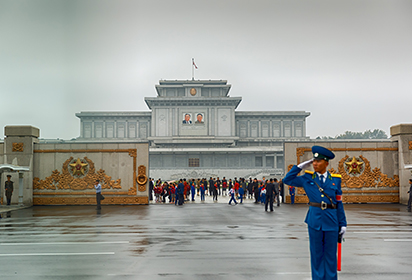Written by Henry Marr
All roads in North Korea lead to Pyongyang. This obsessively centrally planned city, where seemingly everything has its place and purpose, was designed as a workers’ utopia – it’s where Kim Il Sung was born, where dreams are made and where the former leaders are laid to rest. For tour groups it is the starting point of any trip to the DPRK, home to dozens of ostentatious monuments, statues and buildings of import that will undoubtedly impress in their sheer magnitude. Indeed, there is a great deal to wow, charm and surprise in this mysterious capital, where the slight undercurrent of a Cold War atmosphere always prevails, injecting a permanent drip of adrenaline into every second spent in the city.
Kim Il Sung Square
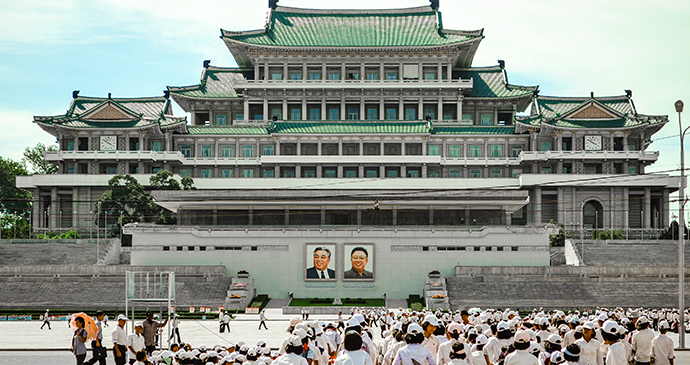
The heart of the nation, Kim Il Sung Square will be instantly recognisable to anyone who has ever seen North Korea on the evening news – being home to the key military parades, mass dances, torchlight processions and other such spectacles that have become such a distinctive image of the country. Standing at the back of the 75,000m2 square with the Taedong River behind you, the Korean Art Gallery is to your left and Korean Central History Museum to your right. Immediately in front of you, the smiling images of the leaders will beam back at you, the small stone in front of them being Point Zero, from where all road distances in the country are measured.
Mansudae Grand Monument
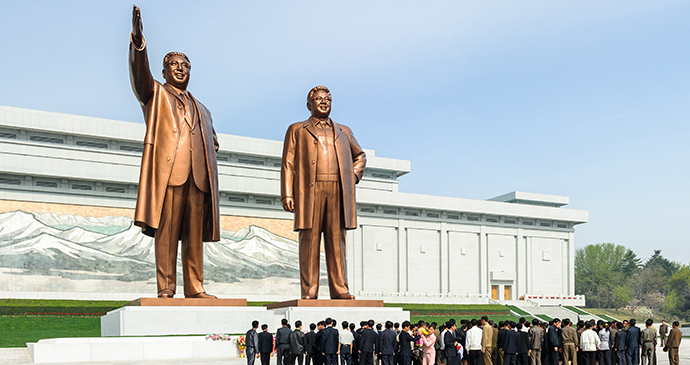
The big draw on Mansu Hill is the unmissable landmark that is the Mansudae Grand Monument, the 20m-tall twin statues of Kim Il Sung and Kim Jong Il. Originally built in 1972 for Kim Il Sung’s 60th birthday, the statue of Kim Jong Il was added hastily in 2012, after his passing. Kim Il Sung’s statue was tweaked when his progeny was placed beside him – the father’s formerly stern face has aged and mellowed, now wearing a smile, his outstretched right arm and body language appearing to say to his son, ‘just look at what we have achieved’, as they look out proudly across the skyline of their city.
Arch of Triumph
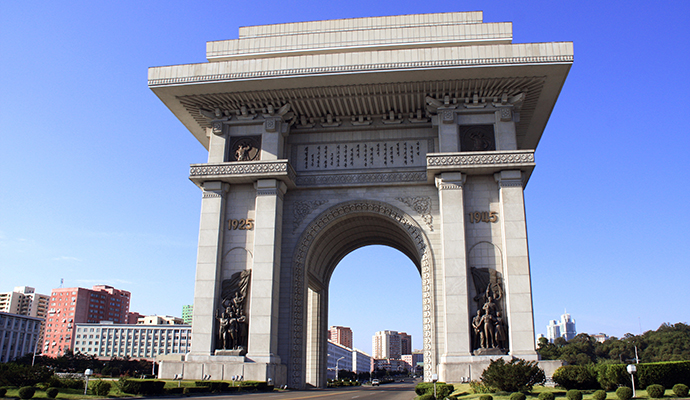
In central Moranbong, this is a major city landmark that all visitors should take in, even if just for a brief photography stop. Unveiled on Kim Il Sung’s 70th birthday (he was a very lucky boy – he was also given the Juche Tower and a few other gifts on this day), this 60m-tall arch is not only 10m taller than the paltry Arc de Triomphe but also 7.5m wider. The face of the arch is inscribed with the lyrics to the ‘Song of General Kim Il Sung’, while the years 1925 and 1945 denote the 20 years Kim spent on the road of national liberation. The four columns of the arch bear intricate reliefs, but the most impressive aspect of the arch (as with many monuments in the country) is its ostentatious scale.
Kumsusan Palace of the Sun
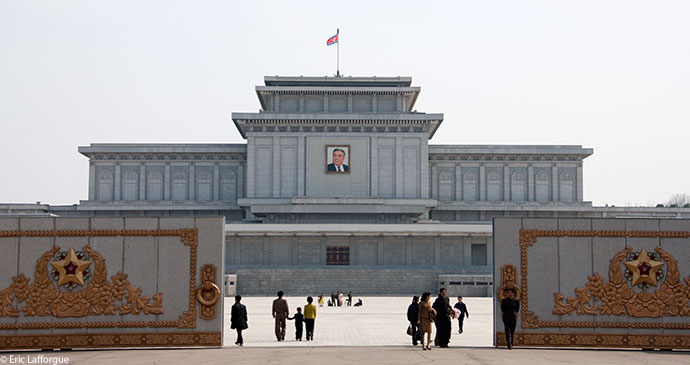
Nestled between the increasingly bustling city and perpetually calm Mount Taesong, beside the sleepy Hapjang Stream, lies the holiest of holies, the Kumsusan Palace of the Sun – the mausoleum for Kim Il Sung and Kim Jong Il. Constructed in the 1970s, the building was the official residence of Kim Il Sung up until his passing in 1994, when it metamorphosed within a year (at a cost estimated in the hundreds of millions of dollars) to become his mausoleum, the Kumsusan Memorial Palace. The palace became a monolith, a windowless mansion tomb from where the Eternal President could continue to rule the country from within his glass sarcophagus, with citizens by the thousand coming each day to pay their respects to the ‘Benevolent Sun’. On Kim Jong Il’s passing in 2011 the mausoleum was a chrysalis once more, re-emerging on 16 February 2012 (what would have been his 70th birthday), as the Kumsusan Palace of the Sun, the largest modern mausoleum in the world and far more impressive than the comparatively humble homes of the likes of Lenin and Mao. With the two leaders lying in state in their respective chambers, the highlight of a tour of this cavernous complex is to bow three times before the embalmed leaders, often surrounded by tearful locals.
Juche Tower
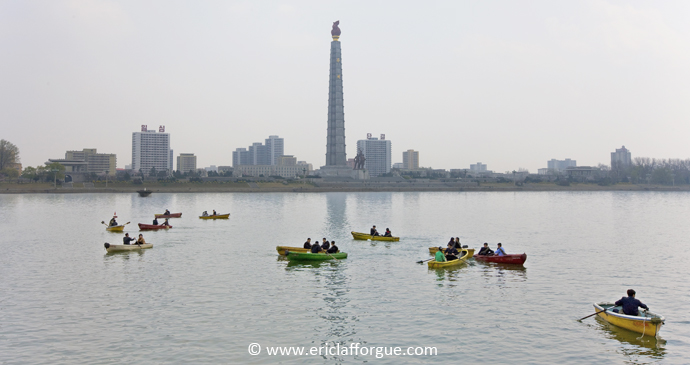
This 170m-tall tower is the highest stone tower in the world and dominates the skyline of central Pyongyang. Often referred to as ‘The Tower of the Juche Idea’, the 150m column is topped with a 45-tonne, 20m-tall metallic torch, its perpetually flickering red glow symbolising the ‘immortality of the Juche idea’. Unveiled on 15 April 1982, Kim Il Sung’s 70th birthday, the exterior of the tower is made from 25,550 white granite blocks, one for each day of his life (the 17 leap days he had lived up until that point were seemingly overlooked by the designer, purported to be Kim Jong Il). In front of the tower stands a striking 30m-tall bronze statue, a sculpture of a worker, farmer and intellectual who is said to symbolise the indomitable Korean spirit, each holding aloft an implement, being a hammer, sickle and writing brush respectively, the three tools converging to form the symbol of the Workers’ Party of Korea, and is reminiscent of Moscow’s famous Worker and Kolkhoz Woman.
Monument to Party Foundation
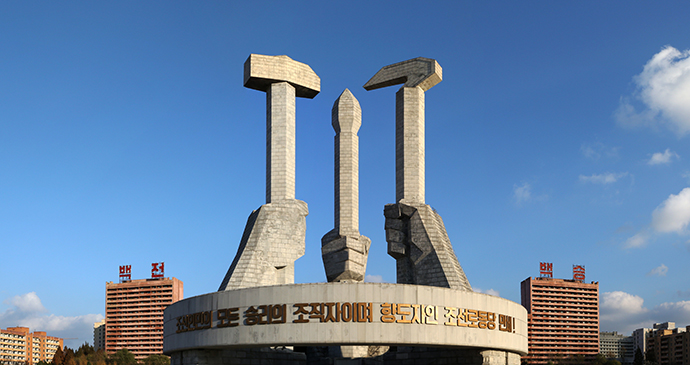
Best approached by the grass avenue that leads towards it for full dramatic effect, this monument was built to commemorate the ‘brilliant history’ of the Workers’ Party of Korea. Erected in 1995 for the 50th anniversary of the party’s foundation, the 50m-high monument (one metre for each year), is made of granite and depicts three clenched fists, one holding a hammer, one a sickle and one a writing brush – the party symbol. A 50m belt surrounds the three fists, symbolising ‘the single hearted-unity of the leader, party and people’, while the 70m pedestal beneath it symbolises that the party’s history stretches back a further 20 years to 1925, when the anti-Japanese ‘Down with Imperialism Union’ was born.
Pyongyang Metro
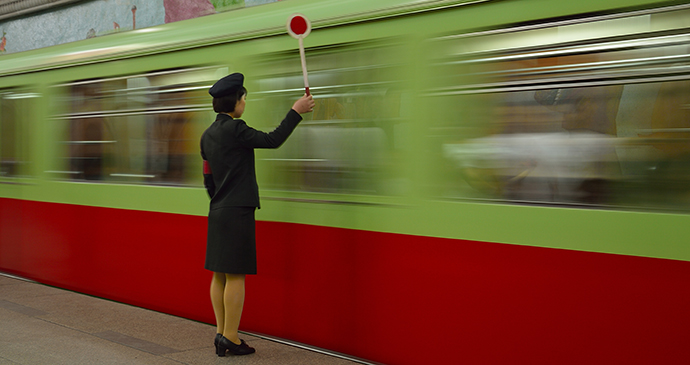
Every visitor to Pyongyang should try and organise a ride on the metro. Architecturally akin to the best Soviet-era metro systems of the USSR, stations often start marbled and minimalist, with piped music echoing down the advertising-free escalator shafts. Escalators and foot tunnels lead through the blast doors to the often cavernous platforms, where the overwhelming and lavish socialist-realist designs unfold and come to the fore, with statues, mosaic murals, bronze reliefs and chandeliers. Trains run every 2–7 minutes dependent on the time of day, and the system ostensibly runs from 06.00 to 21.30, with a single journey costing just five won. As part of a tour, tourists typically travel one stop from Puhung to Yonggwang, chiefly as these are considered the two most impressive stations.
Inspired to start planning a trip to the most secretive capital in the world? Then grab a copy of our comprehensive guide:
